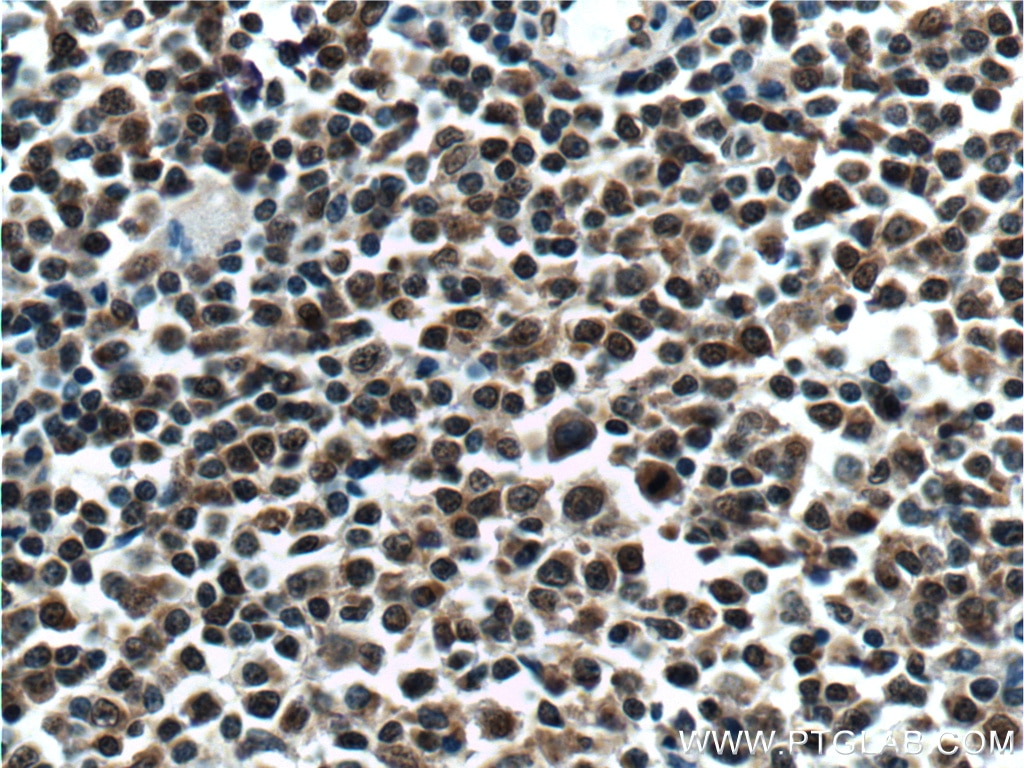- Featured Product
- KD/KO Validated
KMT2D Polyklonaler Antikörper
KMT2D Polyklonal Antikörper für IHC, WB, ELISA
Wirt / Isotyp
Kaninchen / IgG
Getestete Reaktivität
human
Anwendung
WB, IHC, IF, ChIP, ELISA
Konjugation
Unkonjugiert
Kat-Nr. : 27266-1-AP
Synonyme
Galerie der Validierungsdaten
Geprüfte Anwendungen
| Erfolgreiche Detektion in WB | HEK-293-Zellen |
| Erfolgreiche Detektion in IHC | humanes Mammakarzinomgewebe, humanes Kolonkarzinomgewebe, humanes Lymphomgewebe Hinweis: Antigendemaskierung mit TE-Puffer pH 9,0 empfohlen. (*) Wahlweise kann die Antigendemaskierung auch mit Citratpuffer pH 6,0 erfolgen. |
Empfohlene Verdünnung
| Anwendung | Verdünnung |
|---|---|
| Western Blot (WB) | WB : 1:2000-1:16000 |
| Immunhistochemie (IHC) | IHC : 1:50-1:500 |
| It is recommended that this reagent should be titrated in each testing system to obtain optimal results. | |
| Sample-dependent, check data in validation data gallery | |
Veröffentlichte Anwendungen
| KD/KO | See 1 publications below |
| WB | See 3 publications below |
| IHC | See 5 publications below |
| IF | See 2 publications below |
| ChIP | See 2 publications below |
Produktinformation
27266-1-AP bindet in WB, IHC, IF, ChIP, ELISA KMT2D und zeigt Reaktivität mit human
| Getestete Reaktivität | human |
| In Publikationen genannte Reaktivität | human |
| Wirt / Isotyp | Kaninchen / IgG |
| Klonalität | Polyklonal |
| Typ | Antikörper |
| Immunogen | KMT2D fusion protein Ag26195 |
| Vollständiger Name | myeloid/lymphoid or mixed-lineage leukemia 2 |
| Berechnetes Molekulargewicht | 593 kDa |
| Beobachtetes Molekulargewicht | 593 kDa |
| GenBank-Zugangsnummer | NM_003482 |
| Gene symbol | MLL2 |
| Gene ID (NCBI) | 8085 |
| Konjugation | Unkonjugiert |
| Form | Liquid |
| Reinigungsmethode | Antigen-Affinitätsreinigung |
| Lagerungspuffer | PBS mit 0.02% Natriumazid und 50% Glycerin pH 7.3. |
| Lagerungsbedingungen | Bei -20°C lagern. Nach dem Versand ein Jahr lang stabil Aliquotieren ist bei -20oC Lagerung nicht notwendig. 20ul Größen enthalten 0,1% BSA. |
Hintergrundinformationen
KMT2D (a COMPASS/ Set1 family member; also known as MLL4, ALR, and MLL2) is the biggest H3K4 methyltransferase among the most frequently mutated genes in many different types of cancer (PMID: 34194626). The enzymatic function of KMT2D depends on a cluster of C-terminal conserved domains, including a PHD domain, two FY-rich motifs (FYRC and FYRN) and a catalytic SET domain. KMT2D has two frequently occurring genomic alterations: truncation and missense mutations. Loss of KMT2D is a bona fide tumor suppressor gene in FL and DLBCL. Kmt2d perturbed the expression of genes that sustain proliferation and survival, and the KMT2D protein directly binds and associates with an active chromatin conformation in negative modulators of the BCR and lymphocyte migration pathways, which in turn could affect B cell responses to antigen(PMID: 26366712).
Protokolle
| Produktspezifische Protokolle | |
|---|---|
| WB protocol for KMT2D antibody 27266-1-AP | Protokoll herunterladen |
| IHC protocol for KMT2D antibody 27266-1-AP | Protokoll herunterladen |
| Standard-Protokolle | |
|---|---|
| Klicken Sie hier, um unsere Standardprotokolle anzuzeigen |
Publikationen
| Species | Application | Title |
|---|---|---|
Cancer Immunol Res Molecular Subgroups of Intrahepatic Cholangiocarcinoma Discovered by Single-Cell RNA Sequencing-Assisted Multiomics Analysis. | ||
Oncogene Histone 3 lysine-27 demethylase KDM6A coordinates with KMT2B to play an oncogenic role in NSCLC by regulating H3K4me3. | ||
Cell Biosci Histone methyltransferase KMT2D cooperates with MEF2A to promote the stem-like properties of oral squamous cell carcinoma. | ||
Thorac Cancer RNF213 gene mutation in circulating tumor DNA detected by targeted next-generation sequencing in the assisted discrimination of early-stage lung cancer from pulmonary nodules. | ||
Cell Death Discov Pseudogene ACTBP2 increases blood-brain barrier permeability by promoting KHDRBS2 transcription through recruitment of KMT2D/WDR5 in Aβ1-42 microenvironment. | ||
World J Gastrointest Oncol KMT2D deficiency enhances the anti-cancer activity of L48H37 in pancreatic ductal adenocarcinoma.
|








